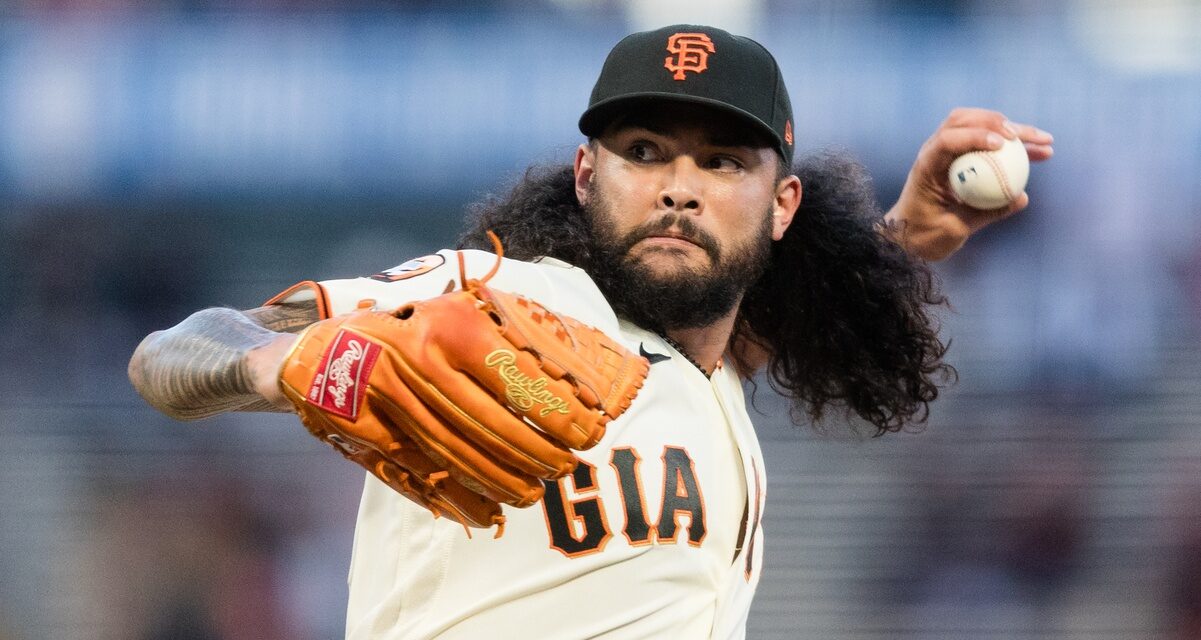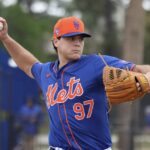On Sunday morning the Mets shored up their rotation with the signing of Sean Manaea, giving them five bona fide starters. They signed him to a one-year deal with a player option, that can max out at 2 years and $28M. While Manaea has experienced some success in his career, he’s been closer to league average through his first 1000 innings pitched. His career ERA- is exactly 100 and his FIP- is only a tick below at 98, so basically he’s been incredibly average so far in his career. Paying $14M for league-average production is a slight underpay for the Mets as league-average players generally accrue about $16M of value over a whole season.
This slight underpay could be a symptom of tacking on the player option but could also be due to Manaea coming off of a down season. Yet, basically what the Mets paid for as well as his career numbers correlate with Manaea’s projections as a good third starter or poor number two starter. Although, there may be cause for optimism due to a few important changes Manaea made leading up to and during the 2023 season.
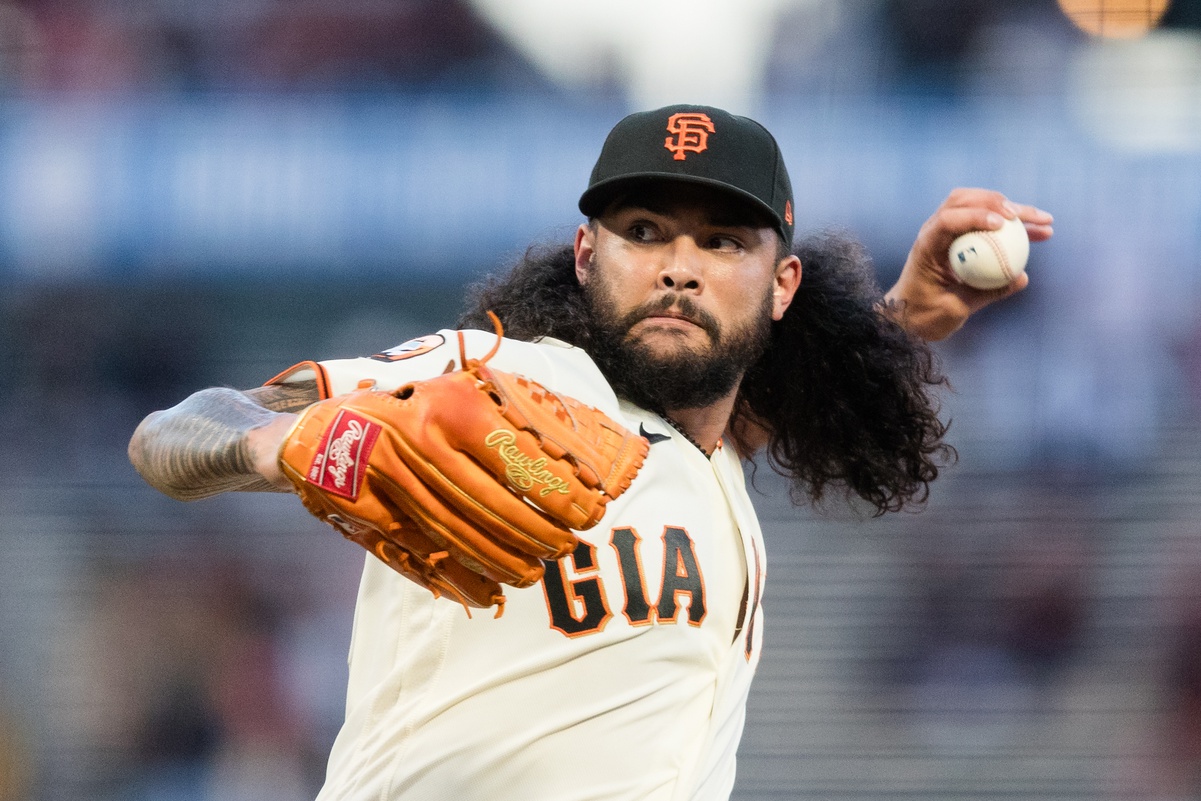
Photo by John Hefti-USA TODAY Sports
Mechanics
Manaea underwent a major mechanical overhaul in addition to changing his foot placement on the rubber between his pitching appearance on May 17th against the Phillies and May 22nd against the Twins. From the 22nd until the end of the season Manaea threw 90 innings and had a triple slash line of 3.40/3.04/3.74 (ERA/FIP/xFIP). In the 27.2 innings pitched prior, he had an unseemly slash line of 7.81/6.69/4.90.
Manaea has a very unique delivery and arm angle, he hides the ball very well and gets elite extension on his pitches. This makes it extremely difficult for hitters to pick up the ball out of his hand, which is a huge advantage and contributes to Manaea’s ability to tunnel his pitches. Manaea had a history of shoulder trouble, which was mainly caused by improperly utilizing his body during his delivery as a way to generate power. He instead leaned too heavily on his arm to generate that velocity which ended up adversely affecting both his health and his velocity.
Coming into the season, Manaea started utilizing his lower half much more efficiently and has exploded forward using the torque created in his hips. This was undoubtedly a major contributor to his spike in velocity which reached 97 MPH at times. The problem was, while effectively applying this newfound power, he was struggling to stay balanced above the rubber and through his delivery.
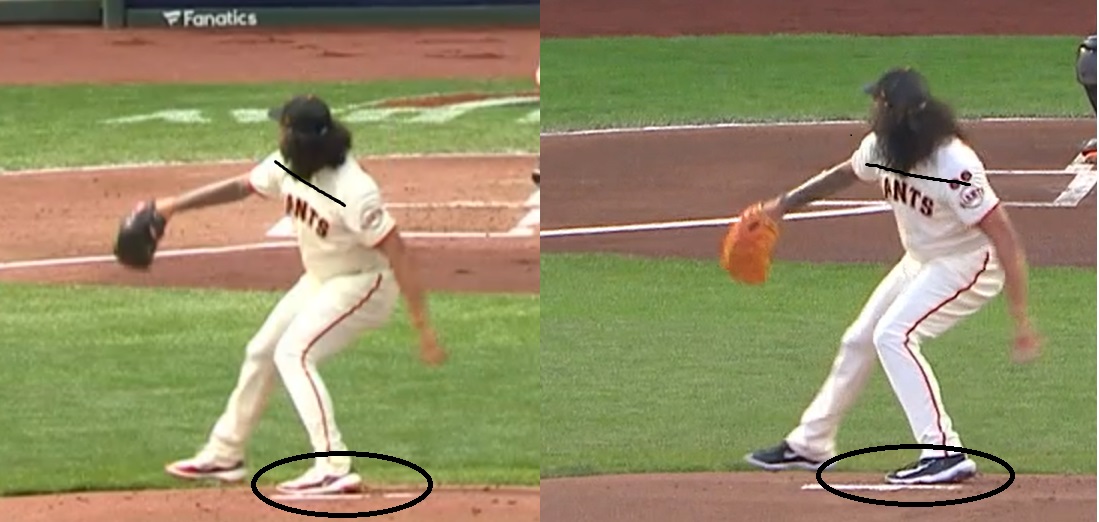
On the left, Sean Manaea from his start against the Royals on April 8th. On the right, his start against the Padres on September 27th.
Above you can see that over the first couple months of the season, Manaea had a severe shoulder tilt which contributed to his left arm being overly stiff. This also affected his ability to maintain his equilibrium, as it almost looked like Manaea was going to throw the ball to first base in the left frame. Later on in the season, Manaea straightened out his shoulders and was able to balance himself while creating a stronger base and a looser left arm.
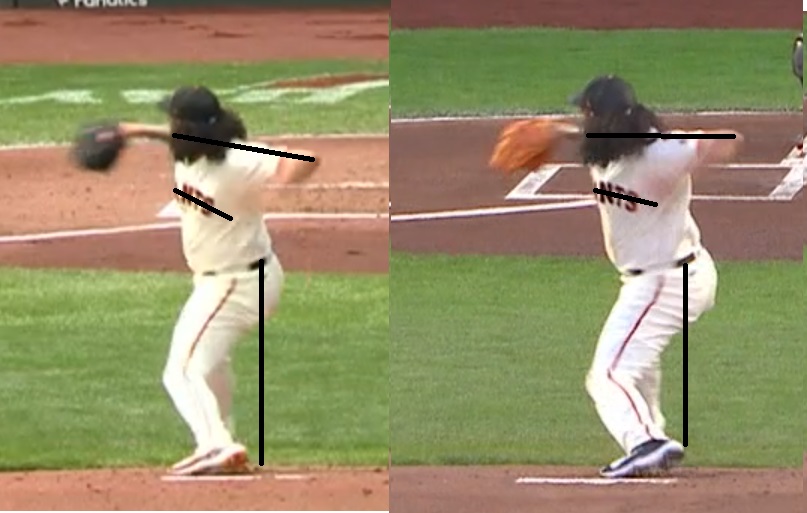
On the left, Sean Manaea from his start against the Royals on April 8th. On the right, his start against the Padres on September 27th.
Here you can see a continuation of the trend in Manaea’s delivery as he was not properly balanced. His upper torso is open and his shoulders are on a downward plane, clearly tilted as well as his rear end not properly aligning above his heel. This was promptly fixed by Manaea as, in the right frame, he was able to establish stability over the rubber while maintaining control of his body and directionality, staying square toward the plate throughout his delivery.
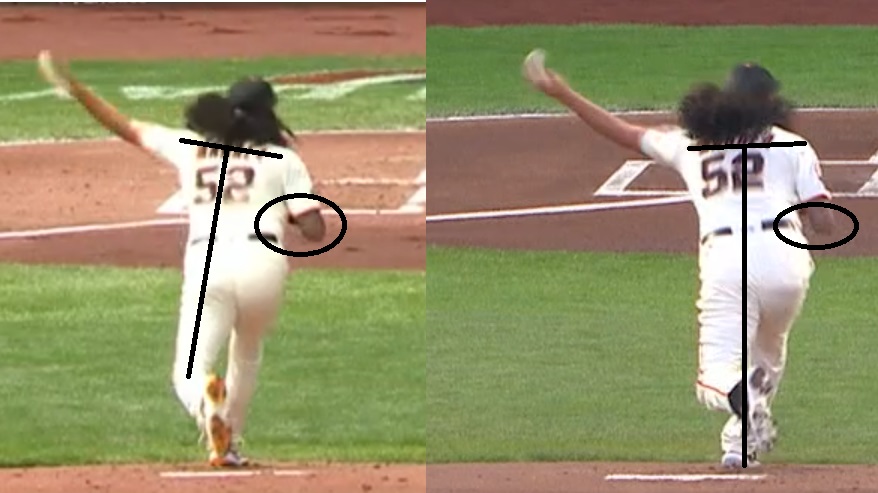
On the left, Sean Manaea from his start against the Royals on April 8th. On the right, his start against the Padres on September 27th.
Finally, upon releasing the ball you can see that Manaea lowered his released point ever so slightly, after making his wholesale mechanical alterations. Even more importantly when considering that with both his back and shoulder on a straight plane, parallel to the mound, his arm was taking a more natural path. You can see how much better Manaea’s steadiness was later on in the season, as in these images, he is sloping as he delivers the pitch on the left and is not aligned with his center mass. On the right he is straight up, his shoulders are parallel to the ground and perpendicular to his center mass.
Maybe most importantly, Manaea kept his right elbow properly tucked into his body allowing him to stay square to the plate. While he must have made this change in addition to all the vast mechanical modifications, this was undoubtedly made simpler once Manaea was properly stable throughout his delivery.
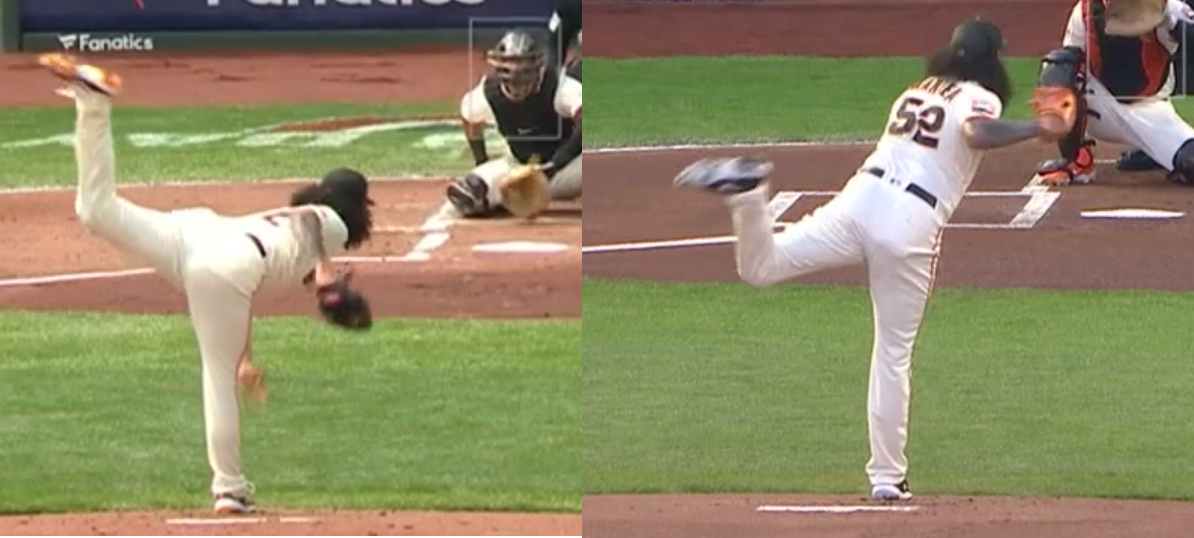
On the left, Sean Manaea from his start against the Royals on April 8th. On the right, his start against the Padres on September 27th.
As seen abundantly clearly in the last side-by-side, Manaea’s newfound balance led to him finishing his delivery without anything overly awkward happening to his body. While the left frame shows how athletic Manaea is, it also shows a pitcher improperly finishing his delivery while putting undue strain on his body. On the right, Manaea finishes his delivery upright and in a much more savory position.
Repertoire
Manaea experienced an extreme uptick in velocity this season compared to last and that uptick did not vary much while he underwent his mechanical makeover. Manaea spent the offseason working at driveline baseball where he learned how to maximize his delivery and create more velocity. His fastball velocity spiked by 2.5 MPH, up from 91.1 MPH in 2022 which was his all-time low. His career average velocity was slightly under 92 MPH, so the increase was almost 2 MPH higher than he’s been able to throw for most of his career.
Interestingly, the Mets’ Director of Pitching Development was one of the founders and key members of Driveline and therefore may have an insider’s view of how they helped Manaea improve. This can also be somewhat of a comfort for Manaea as he can now work on what he did last offseason within the confines of the Mets pitching lab while getting insight directly from Eric Jagers.
Based on the data from various online sources, Manaea seemingly switched to throwing a sweeper right after making the aforementioned mechanical adjustments. While this may be the case, it is also wholly possible the shape of his slider happened to change due to these mechanical adjustments. What we know for sure is that Manaea can vary the speed of his slider(s) as he has thrown them anywhere from the high 70s to the high 80s, a pretty significant and unique range.
What is unclear to me is if the data collected by the various outlets take Manaea’s midseason adjustment in release point into account. If they calculate the movement of his pitches off of an average of his release points, given Manaea’s two release points in 2023, it would look as if he was throwing two separate pitches. This can be backed up by the fact that when comparing his sweeper and slider based on shape alone, there are minimal differences. These differences, which may very well be statistical noise, exist in every area except for horizontal movement. As their vertical movement, spin deflection and extension are almost identical.

Image courtesy of FanGraphs, shows Manaea’s release point superimposed on the graph of his pitch movement
Manaea slightly dropping his arm angle while changing where he stood on the rubber explains why it looks as if he was throwing both a slider and a sweeper. Yet clearly, he can manipulate the velocity of these sliders while achieving a similar shape. As you can see from the image above, not only did Manaea’s “two” sliders correlate with his shift in release point, but his changeup as well, has two almost distinct areas that separate the two offerings in accordance to the altered release point.
Aside from a shift in velocity, Manaea, according to pitch data from numerous outlets eschewed his 2-seam fastball, which he used exclusively in 2022, for a 4-seamer in ’23. This is seemingly untrue, as after watching several of Manaea’s games from 2023, he used his 2-seam fastball at least a handful of times per game, which far exceeds even the most extreme counts of any of the pitch data collected on him. It is hard to determine how often Manaea used each one of his fastballs, the fact that he was throwing both explains why it is exceedingly difficult to separate his fastballs from his release points in the same way we did for his slider and changeup.
Location
Put simply, when Manaea has control, he is an above-average pitcher. The years in which he was able to mitigate walks were the seasons in which he was above average. While Manaea has never had serious walk issues, his walk rate has fluctuated throughout his career, and keeping his walks to a minimum is how he has succeeded. After going through his mechanical machinations, Manaea did just that, suppressing his walks and having success. Yet, command still stands out as an area in which Manaea has trouble. His ability to locate his repertoire within the strike zone alludes Manaea at times and what saves him from being overly hittable is his ability to tunnel his pitches.
The peculiar arm angle and excellent extension Manaea gets help him keep batters confused and off balance. This is what provides him the luxury of being inexact with his pitches within the strike zone. That being said, this inability to locate his pitches consistently is the reason why Manaea’s ceiling is that of a good number two starter and not of an ace. He is not fine with his location, does not hit the catcher’s mitt with any consistency and oftentimes leaves pitches over the middle of the plate. This is truly a weakness of Manaea’s and if he can ever figure this part of his game out, he could become an upper-echelon starter.
While that is an unlikely outcome for Manaea in 2024, he was not signed to be an ace. Rather, he was brought in to fill key innings for a team that sorely needed a horse. Someone who may look spectacular at times, but will more than anything give a strong effort on the mound every fifth day. Seemingly Manaea has become a much better pitcher than people realize. His season was befuddling as he underwent an almost complete facelift during the 2023 season, which muddled his bottom line. Yet when you combine scouting and stats it tells the story of a pitcher who may have just started to figure things out.


